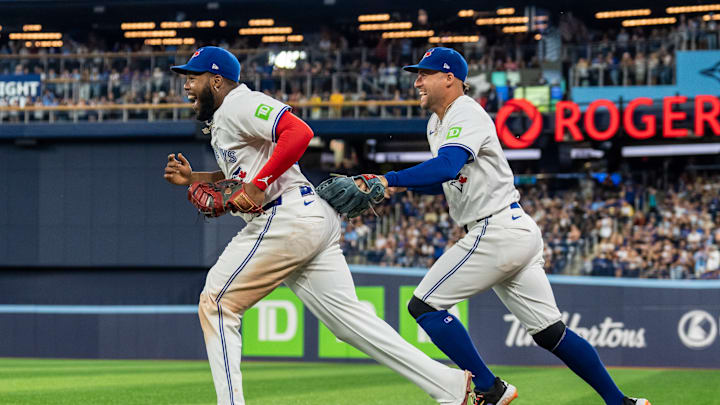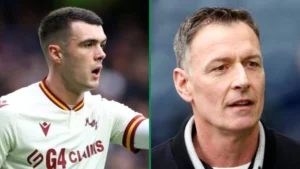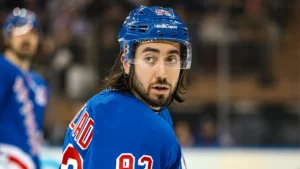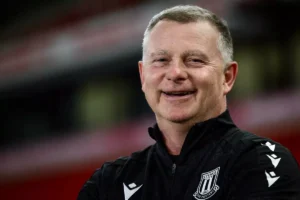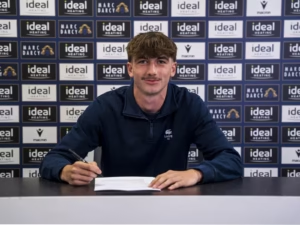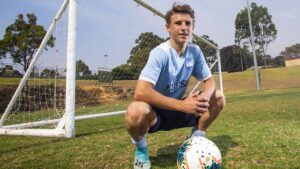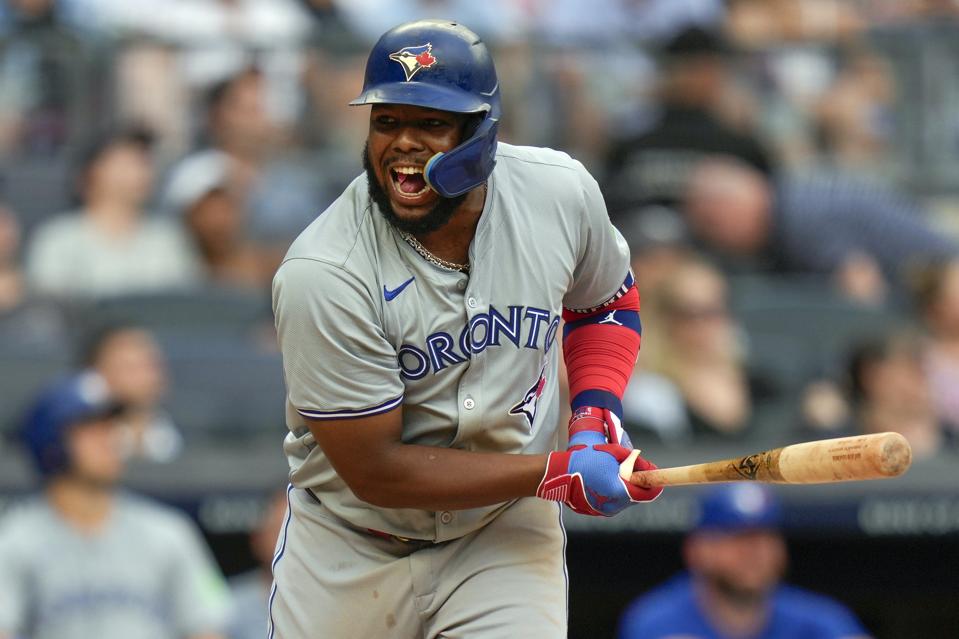
Vladimir Guerrero Jr. contract drama has masked electric start from one Blue Jays star
The Toronto Blue Jays have dominated the headlines over the last few months for a few different reasons, but they all revolve around superstar first baseman Vladimir Guerrero Jr. Guerrero is entering the final year of his contract and will head into free agency at the end of the 2025 season. Toronto has worked hard to try to extend his contract, but the front office has failed to meet his demands.
The lack of a contract extension led many around the league to believe the Blue Jays could eventually look into trading Guerrero in a move that would be reminiscent of the San Diego Padres’ decision to trade Juan Soto to the New York Yankees. Those trade rumors have since died down as Guerrero Jr. and the Blue Jays continue to engage in contract extension talks.

The fact that the two sides are still discussing a potential contract is good news for the Blue Jays because a lot of superstars would have shut those discussions down and told the team to sign him in free agency. Initially, Vladdy set a hard deadline of prior to Opening Day for contract negotiations. He has since changed his mind, as Guerrero at least seems willing to discuss a deal this season, even if it’s unlikely.
But this contract drama has completely overshadowed everything else going on with the team including a very hot start from one of the team’s star outfielders.
For more news and rumors, check out MLB Insider Robert Murray’s work on The Baseball Insiders podcast, subscribe to The Moonshot, our weekly MLB newsletter, and join the discord to get the inside scoop between now and the MLB offseason.
George Springer’s hot start being overshadowed by Vladimir Guerrero Jr. contract drama
Blue Jays outfielder George Springer posted an OPS+ less than 100 for the first time in his career last season. His OPS was below .700 on the season. But this season has been completely different. In 21 at-bats, Springer has a slash line of .429/.520/.667 due to his two doubles, one home run and four walks this season.
This production is huge for the Blue Jays’ pursuit of a postseason spot this summer, which would be huge for the team’s negotiations with the aforementioned Guerrero.
It’s unlikely that Springer can perform at an 1.100 OPS rate for the entire season, but the fact that he’s doing so through seven games is a great sign for a team that could have considered cutting him during the offseason.
MLB teams with the most home runs in a single season

The New York Yankees opened the 2025 season by hitting 15 home runs in their first three games. The display of power not only helped the defending American League champions secure a series sweep of the Milwaukee Brewers, it also tied the 2006 Detroit Tigers for the most homers by a team in its first three games in MLB history. The 2006 Tigers reached the World Series after finishing the regular season with 203 home runs, short of the MLB single-season record of 307 jointly held by the 2019 Minnesota Twins and 2023 Atlanta Braves.
Here is a look at the MLB teams with the most home runs in a single season in the modern era (post-1900):
First impressions from the Athletics’ new home opener
A local television news crew was stationed outside the Sawyer Hotel in downtown Sacramento on Sunday night, ready to catch every nuance of the magical moment the bleary-eyed Chicago Cubs stepped off their bus to enter the lobby. This was the first time a major league baseball team had arrived in Sacramento to play a legally sanctioned regular-season game, and no story was too small. If you ever wondered what Ian Happ looks like walking toward a hotel and being surprised by the presence of a camera and a reporter, CBS-13 was the channel for you.
“That was different,” Cubs pitcher Matthew Boyd said. “But it’s the first time a big league team has come to Sacramento, and they’re excited. Baseball’s that cool thing that brings everyone together.”
It was quite a week for Sacramento — more specifically, West Sacramento, the place with the street signs declaring it “The Baseball Side of the River.” It got to host the first three games of the Athletics’ expected three-season interregnum between Oakland and Las Vegas, and it got to call a big league team its own, even if the team has decided to declare itself simply the Athletics, a geographically nonspecific generic version of a Major League Baseball team.
It’s tough to explain the vibe at Sutter Health Park for the first series. It looked like big league baseball and sounded like big league baseball; it just didn’t feel like big league baseball. The crowds were mostly sedate, maybe because there’s room for only about 14,000 fans, and maybe because the Athletics were outscored 35-9 over the course of the three games, the first and third of which could have been stopped for humanitarian reasons.

This is a team that is supposed to be better this season, and three games shouldn’t change that expectation. It spent some money nobody knew it had on a free agent contract for Luis Severino and extensions for Brent Rooker and Lawrence Butler, moves that assured a payroll high enough to abide by the revenue-sharing rules of the collective bargaining agreement, but moves that improved the team nonetheless. (You’ve got to spend money to make money is an adage that, for the first time, appealed to owner John Fisher.) The A’s have a universally respected manager in Mark Kotsay, several promising young players from recent drafts and the confidence that came from playing really good baseball over last season’s second half. There is a creeping suspicion that they could be building something that could make West Sacramento proud.
It’s a long, maybe even interminable season that will contain every iteration of peak and valley. Three games can end up being the equivalent of one breath over the course of a lifetime. But still, it’s impossible to deny the Athletics brought back a lot of their old classics for their Sacramento debut: They walked 10 batters in Monday night’s home opener; they kicked the ball around enough for four unearned runs in three games; they walked seven more Wednesday afternoon. The crowds were mostly quiet; the numerous Cubs fans were noisy until it felt mean, but the A’s fans, when they found something cheer-worthy, reacted as if they were cheering for someone else’s kid at a piano recital. As first impressions go, it could have been better.
The A’s players, in their defense, are going through an adjustment period. When I asked closer Mason Miller how he likes Sacramento, he starts counting on his fingers and says, “I’ve literally spent five nights here.” They’re young, wealthy and accustomed to living in a new place every season as they progress through the minor leagues, and they’re trying to view their new home as an opportunity to bond over experiencing something together for the first time.
“We’re all new here,” rookie second baseman Max Muncy says, “so even though I’m a rookie, I can earn some cred if I find a good restaurant and let everyone know.” I mention the toughest reservation in town, a Michelin-starred, fixed-price restaurant less than 2 miles away.
“That sounds like a two-month wait,” he says.
“Not if you tell them who you are,” I joke.
“Yeah, I can’t imagine doing that,” he says. “Besides, if I say, ‘Max Muncy,’ when I show up they’ll say, ‘Oh great, we got this one.'”
The A’s bigger concern is playing the next three seasons in a minor league ballpark and sharing it with a minor league team, the Triple-A Sacramento River Cats. It’s kind of like a senior rooming with a freshman; the senior has dibs on just about everything, but he still has to deal with the roommate. For the A’s, that means wondering how the field will hold up over the course of the 155 games it’ll wear this season, and figuring out how to cope with having a clubhouse beyond the outfield wall, disconnected from the dugout.
Severino made his first home start for the A’s on Tuesday night, and he had to tweak his routine to account for the new reality: Once he left the clubhouse, there was no going back. It was cold and windy, so he had to make sure his jacket made it to the dugout with him. The notes he likes to reference during the game had to be there, too. His usual practice of popping into the clubhouse to watch the game on television while his team hits (“It looks easier and more fun on TV,” he says with a laugh) is on hold for home starts for the foreseeable future. He had to sit there with his teammates whether he pitched well or not — on Tuesday: not — and know that every one of his emotions would be picked up by at least five cameras.
“You just have to stick it out,” Severino says. “You can’t have all the stuff you have in a normal stadium. When you go out there, you have to bring everything with you. You have to try to stay warm and find out a different routine. It’s not the same, but the thing is, it doesn’t matter because it’s happening, and we need to get used to it. Just treat it like spring training, because it feels like spring training.”
Players coming off the bench to pinch-hit or play defense have nowhere to get loose. In any other park, they’d jump into the cage behind the dugout and take some swings or stretch out and run a few sprints. Here, they have to do whatever they can do within the confines of the dugout. “Just do some arm circles and maybe run in place,” Cubs infielder Jon Berti says. “Make it old-school.”
Just one of the three games sold out, an unexpected development after months of civic backslapping and grand proclamations about Sacramento cementing its status as a major league city. Tickets for Wednesday’s game, which drew 9,342 fans, were selling on the secondary market for $20 about 30 minutes before first pitch. The A’s have the highest median ticket prices — $181 — in baseball, according to data compiled by the ticket app Gametime. The idea was to employ the time-honored scarcity=demand concept to seize maximum profits from minimal opportunities, but one sellout — the opener, which also included roughly 2,000 comped tickets — in the first three games shows the A’s remain capable of straining even the most fundamental economic concepts.
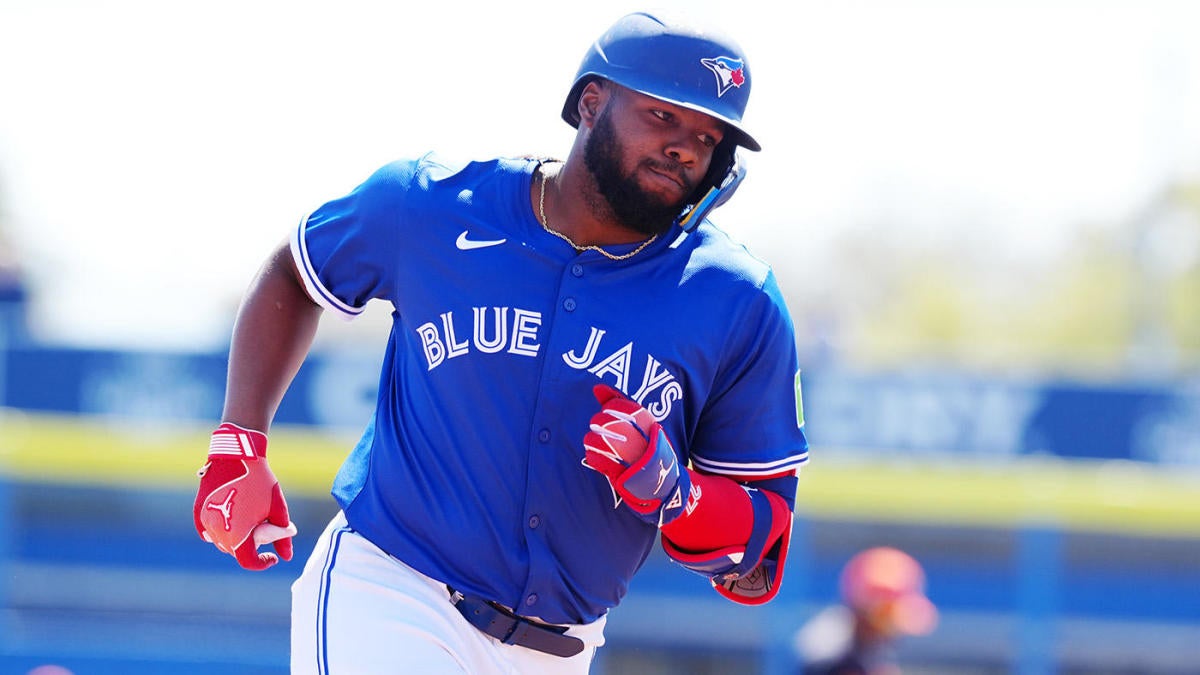
It’s probably not fair to judge Sacramento’s worth as a baseball town based on its willingness to support a team that won’t be identified by the city’s name during its time here. And it’s definitely not fair to judge a region based on the number of fans eager to hand money to an owner who pulled the team out of Oakland after 57 years and is on his way to Las Vegas.
In the days after Kings/River Cats owner Vivek Ranadive joined with Fisher to bring the A’s to Sacramento, someone identified to me as “as Sacramento as it gets” sent a text that illustrates the conflict that lives within the Sacramento sports fan:
So many thoughts as I’ve been following this:
1) I hate it in that we are just bailing out Fisher
2) I hate that we are basically acting as Seattle a decade ago with regards to the Kings and poached the A’s away from Oakland. That’s an awful feeling I wish on no one
3) I am interested to see if this actually goes anywhere other than just bailing out Fisher for 3 years while he waits out whatever magic is gonna happen in LV
4) Reeeeeally wish Vivek read the room on this one
